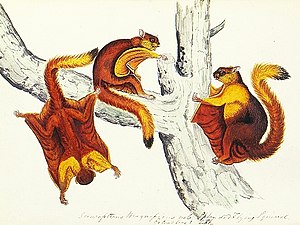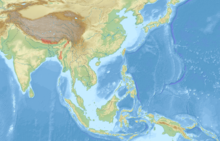Hodgson's giant sliding squirrel
| Hodgson's giant sliding squirrel | ||||||||||||
|---|---|---|---|---|---|---|---|---|---|---|---|---|

Hodgson's giant flying squirrel ( Petaurista magnificus ) |
||||||||||||
| Systematics | ||||||||||||
|
||||||||||||
| Scientific name | ||||||||||||
| Petaurista magnificus | ||||||||||||
| ( Hodgson , 1836) |
The Hodgson giant sliding squirrel ( Petaurista magnificus ) is a flying squirrel from the genus of the giant sliding squirrel ( Petaurista ). It is common in the Himalayas in northern India , Bhutan , Nepal and southern Tibet .
features
The Hodgson giant gliding squirrel reaches a head-trunk length of 36 to 42 centimeters and a tail length of 41.5 to 48 centimeters. The rear foot length is 72 to 78 millimeters, the ear length 41 to 43 millimeters. The species is therefore relatively large within the genus. The back color is brown to reddish brown with a dark brown to black stripe that runs from the head over the back to the base of the tail. There are yellowish-brown spots on the shoulders, which are bordered in red-brown, and the top of the flight membrane is also red-brown in color. The belly and throat as well as the feet are lighter red-brown. The base of the tail is dark brown, then the tail is red-brown over most of its length and has a black tip. Compared to the spotted giant flying squirrel ( Petaurista elegans ), with which it sometimes occurs sympatric , it is about 25% larger.
Like all giant flying squirrels, it has a large and hairy flight membrane that connects the wrists and ankles and is enlarged by a fold of skin between the hind legs and the base of the tail. The flight membrane is muscular and reinforced at the edge, it can be tensed and relaxed accordingly in order to control the direction of gliding.
The total length of the skull is 65 to 74 millimeters.
distribution
The Hodgson giant sliding squirrel occurs on the southern edge of the Himalayas in northern India in the state of Sikkim , also in Nepal and Bhutan and in southern Tibet in the People's Republic of China (Xizang Province). In addition, the species is probably native to northern and northwestern Myanmar .
Way of life
The Hodgson's giant gliding squirrel lives in evergreen forests and deciduous forests of the Himalayas from the valleys up to heights of 3000 meters, a preference for deciduous forests is assumed. It is strictly arboreal and largely nocturnal and feeds on leaves, buds and flowers of rhododendrons and other trees as well as fruits and grasses. Like all other flying squirrels, this species is able to glide long distances back by jumping off a tree. Individuals of the species were observed as they glide 60 to 100 meters and make a slight arc upwards to land.
The species builds nests of moss and other soft material with a round entrance in hollow trees or in the branches of higher trees at heights of 10 to 15 meters. Communication takes place using different tones, with a monotonous booming sound typical of their evening appearance. Little data is available on reproductive behavior.
Systematics
The Hodgson giant sliding squirrel is classified as an independent species within the genus of the giant sliding squirrel ( Petaurista ), which contains a total of eight to nine species. The first scientific description comes from Brian Houghton Hodgson from 1836 on the basis of individuals from central and northern Nepal. Originally the species also included the Bhutanese giant sliding squirrel ( Petaurista nobilis ), which has now been recognized as a separate species.
In addition to the nominate form P. m. magnificus no further subspecies are distinguished.
Existence, endangerment and protection
The Hodgson's giant flying squirrel is classified as least concern by the International Union for Conservation of Nature and Natural Resources (IUCN) due to its large distribution area and its supposedly large populations. In parts of the distribution area it is considered rare and a decline in populations is assumed , mainly due to habitat loss due to the conversion of former forest areas into tea plantations and other agricultural crops such as cardamom fields . In addition, logging and forest fires as well as other anthropogenic influences are sources of danger, including regionally the hunt for animals as a meat supplier. In the area where the type was found in Nepal, the original habitat has already been completely transformed.
supporting documents
- ↑ a b c d e f Hodgson's Giant Flying Squirrel. In: Andrew T. Smith , Yan Xie: A Guide to the Mammals of China. Princeton University Press, 2008; Pp. 178-179. ISBN 978-0-691-09984-2 .
- ^ A b c Richard W. Thorington Jr., John L. Koprowski, Michael A. Steele: Squirrels of the World. Johns Hopkins University Press, Baltimore MD 2012; 115. ISBN 978-1-4214-0469-1
- ↑ a b c Petaurista magnificus in the IUCN Red List of Threatened Species 2010.4. Posted by: S. Molur, 2008. Retrieved June 14, 2014.
- ↑ a b c d Don E. Wilson & DeeAnn M. Reeder (eds.): Petaurista magnificus in Mammal Species of the World. A Taxonomic and Geographic Reference (3rd ed).
literature
- Richard W. Thorington Jr., John L. Koprowski, Michael A. Steele: Squirrels of the World. Johns Hopkins University Press, Baltimore MD 2012; 115. ISBN 978-1-4214-0469-1
- Hodgson's Giant Flying Squirrel. In: Andrew T. Smith , Yan Xie: A Guide to the Mammals of China. Princeton University Press, 2008; Pp. 178-179. ISBN 978-0-691-09984-2 .
Web links
- Petaurista magnificus inthe IUCN Red List of Threatened Species 2010.4. Posted by: S. Molur, 2008. Retrieved June 14, 2014.
